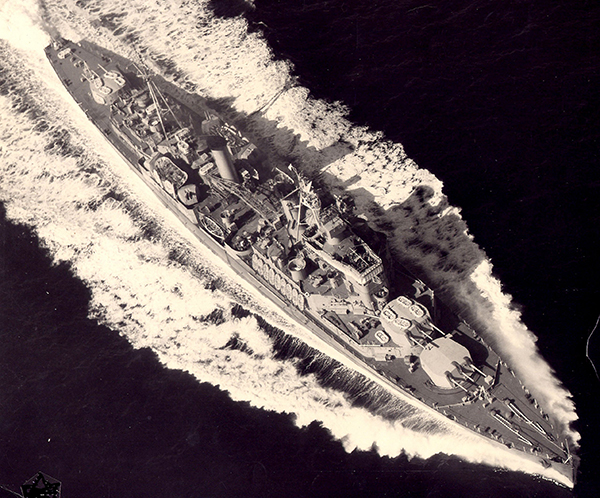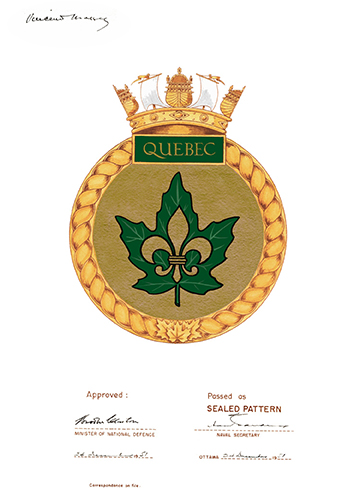HMCS Québec
There has been only one vessel named HMCS Québec in the Royal Canadian Navy.
HMCS Uganda / Québec (C66 / 31)
As HMS Uganda, the name ship of her class of light cruisers, she was completed 3 January 1943 at Vickers-Armstrong Ltd., Newcastle-on-Tyne, England. After working up with the Home Fleet (the Royal Navy’s War Fleet), she joined Plymouth Command in April for operations in the Bay of Biscay and the English Channel, and in July joined the 15th Cruiser Squadron, Mediterranean Fleet, as part of Force K. She was badly damaged by a German glider bomb on 13 September 1943, while supporting the Allied landings at Salerno, Italy, and arrived at Charleston, South Carolina in November for a year of repair work.
Presented to the Royal Canadian Navy, the ship was commissioned HMCS Uganda on 21 October 1944 at Charleston, and in November returned to the United Kingdom for further modifications. She left in January 1945 for the Pacific via the Suez Canal, to join the 4th Cruiser Squadron, British Pacific Fleet. In April, she joined Task Force 57 in the Okinawa area, and was thereafter principally employed in screening the fleet’s aircraft carriers operating against Japanese airfields in the Ryukyu Islands, Japan. On 14 June, HMCS Uganda participated in the bombardment of Truk, and in July supported carriers operating against Tokyo. She left the fleet late in July and arrived at Esquimalt, British Columbia, on 10 August for refit.
HMCS Uganda, having been renamed HMCS Québec on 14 January 1952, spent the rest of her career as a training ship. HMCS Québec was one of the vessels representing Canada at the naval review for Her Majesty Queen Elizabeth’s Coronation in June 1953. In that vein she conducted several Pacific cruises “showing the flag”. Paid off on 13 June 1956, she arrived at Osaka, Japan, on 6 February 1961 to be broken up.
- Builder: Vickers-Armstrong Ltd., Newcastle-on-Tyne, England
- Displacement: 8941.2 tonnes
- Dimensions: 169.4 m x 19.2 m x 5 m
- Speed: 33 knots
- Crew: 730
- Armament: (Post war) nine 6-inch (152-mm) guns (3 x III), eight 4-inch (102-mm) guns (4 x II), fourteen 40-mm guns (3 x IV, 2 x I), and six 21-inch (533-mm) torpedo tubes (2 x III).
Motto: “Nos canons parleront” (Our cannons shall speak)

